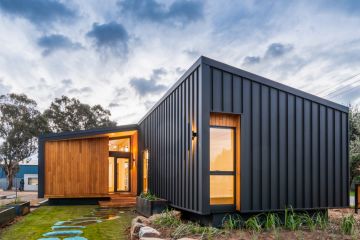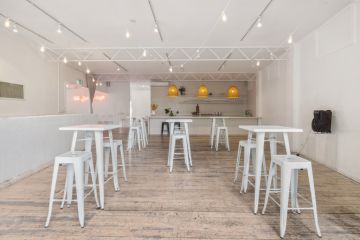Darren Palmer's essential bathroom checklist for DIY renovators
The difference between a great bathroom and a not-so-wonderful one is clear to anyone who has ever navigated the minefield of obstacles in the dark as they made their way through the house in the middle of the night to have a bathroom break, or been crammed into a too-small shower stall. The struggle is real.
Getting a bathroom right adds as much value to a home as getting it wrong takes value away: having a dreary old bathroom can pull down the appeal and value of your home.
If you’re planning a bathroom renovation there are a list of consistent considerations that you should have in mind for a shot at a successful outcome.
Layout
Planning your bathroom layout is a great place to start but before we get to that, take a step back and look at the layout of your whole home to see if there are opportunities to improve not just the bathroom’s layout, but the amenity of your entire home through the location of the bathroom itself.
If you have an opportunity to relocate a bathroom that is in a less-than-ideal or inconvenient spot, have a look at what it might take and cost to do so. By positioning bathrooms close to bedrooms and far enough away for living and entertaining spaces to create an acoustic buffer, you will improve the usability of your home.
Looking at the size and amount of bathrooms in your place can also be an opportunity to add value and functionality. A renovation of one of my previous apartments revealed an opportunity to add a bathroom by simply cutting the current bathroom in two, absorbing the hallway in the process, which made better use of that wasted floor space and allowed the addition of an en suite to the main bedroom, as well as a full-sized bathroom to service the rest of the home.
Only through looking at the floor plan for these opportunities will you find chances to better configure your layout.
- Related: Darren Palmer’s guide to budget renovations
- Related: The Block: Alice Stolz talks bathrooms
- Related: Four of Australia’s most luxurious bathrooms
Planning

There are several rules of thumb when planning the all-important layout of your bathroom. Image: Dan and Carleen’s bathroom, The Block 2016.
Photo: Channel Nine
The success or failure of a bathroom in adding functionality and value also depends largely on how you choose to position the elements within it. There are a few rules of thumb you should consider as constraints to work around when laying out your bathroom spaces.
The position of the door should be such that if you are walking past or looking into the room you see something appealing. The most visually appealing element is often the vanity, followed by a bath and then shower. However, your toilet should be hidden from view wherever possible.
You also need to configure your room so that you have the right amount of space for each element. Showers should be 900 millimetres x 900 millimetres as a minimum, but changing one of these dimensions to 1.1 metres-1.3 metres will yield a more luxuriously proportioned shower space.
Toilets generally sit within an 800 millimetre x 800 millimetres box, with no less than 250 millimetres from the edge of the toilet to the nearest adjoining surface.
The open floor area should ideally be configured as a square of unimpeded space of about 1.5 square metres-2 square metres for most family homes. The more open floor space you can achieve the better so that people are able to move about the space easily, especially in shared bathrooms.
Storage

Many cupboards or drawers you have in your vanity will dictate how usable a bathroom becomes. Image: Chris and Kim’s bathroom, The Block 2016. Photo: Channel Nine
Vanities are a central visual element so great care should go into their planning from size, position, materials, finish and importantly, storage. How many cupboards or drawers you have in your vanity will dictate how usable the bathroom becomes.
Think about how many different uses the vanity has for the variety of its users and what each person may need from it. Hair dryers or straighteners need to be powered, as do electric toothbrushes and shavers.
Day-to-day items of varying sizes need to be concealed and stored, with even more demand placed on the vanity for this purpose if you chose to not include face-level storage.
While not a must, face-level storage is a wise inclusion because it puts day-to-day items at eye level, allowing easy access..
Fashion sometimes suggests the use of mirrored walls or feature mirrors in the place of face-level storage but make sure when you’re planning your bathroom storage than form doesn’t overrule function.
Architectural interest

Photo: Channel Nine
The proportions of a room are one thing that can dramatically add to the appeal of a bathroom. Luxury comes with the freedom of space but often bathrooms are constrained to modest proportions relative to the overall square meterage of the home. A too-big bathroom can grab value from a home just as much as a too-small bathroom.
However, architectural interest isn’t dependent on size. It’s more about looking for opportunities to add or subtract to the fabric of the room by adding niches, skylights, windows or doorways to create a sense of connection to the outdoors.
The detailing of how these changes are made make all the difference, from door-frame colour or material to the size and shape of openings to accommodate skylights, paying attention to the shape and size of voids left in ceilings and the placement of openings in relation to other elements in the room and the views from them.
In more luxurious homes, a fireplace might be a central architectural element that creates drama within the room but whatever your opportunity to add architectural interest, be sure to consider it a priority so as to maximise the drama and interest.
Artificial light

It is important to have good quality artificial lighting over the vanity area. Image: Julia and Sasha’s bathroom, The Block 2016.
Photo: Channel Nine
Skylights and windows provide natural light, which is an absolute must in any great bathroom. Artificial light sources are also extremely important for the creation of ambience as well as practical use.
Consider the position of overhead lighting to highlight areas of high use, such as toilet, shower and bath. Also consider how you best light the vanity area.
You’ll need to think about how easy it is to see the details of the face without shadowing, so the ideal light source is at face level, either flanking the sides of the face, or surrounding it. If neither is available, then overhead lighting from in front of the face will create a comparible result as long as there is light cast downward, in front of the face, as well as reflected from a mirror in front of the face.
Lighting from one side and not the other, or from behind the head is a no-no because you will create areas of shadow that make it hard to see the details and colours of the face.
Materials

A bathroom designed by Darren Palmer as featured HomeSpace. Photo: Felix Forest
Tapware, handles and accessories are an opportunity to add in a metallic contrast to the palette of your bathroom. Look at these options as one whole consideration. You can finish them in the same metal, but be aware that different suppliers may have different colours of metal, especially if you’re looking at gold or brass.
Also consider the patina of the metal, polished, brushed, aged, oil rubbed:all will change the colour and look. If you mix and match metals be sure that they sit well next to each other and set some rules around the use of different metals and where they appear.
Tile choice is a huge consideration but sometimes there are too many options, giving you the headache of finding the perfect choice.

Through tapware, you can contrast metallics against your chosen palette. Image: Julia and Sasha’s bathroom, The Block 2016.
Photo: Channel Nine
It’s important to remind yourself at this point that there is no such thing as perfection, and nor should you concern yourself with trying to replicate what you’ve seen elsewhere. The important thing when choosing tiles is how they will work for you.
Set constraints around tile choices to narrow down your search: think about cost per square metre, shape, size, material (stone, ceramic, porcelain), finish (honed, polished, matt, gloss, satin) and then only look at the tiles that fit all of your constraints. Then be sure that your choices work in symphony with other tiles and materials in your bathroom as well as paying attention to how they relate to your kitchen and the rest of the house.
You also need to think about the timelines of your bathroom renovation, the budget and finding the right suppliers and contractors. It’s through careful planning and management that you stand the best chance of having a successful result.
We recommend
We thought you might like
States
Capital Cities
Capital Cities - Rentals
Popular Areas
Allhomes
More







